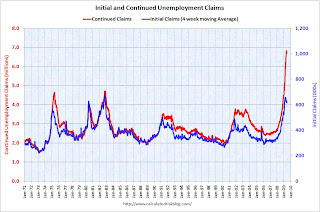by Calculated Risk on 6/25/2009 08:30:00 AM
Thursday, June 25, 2009
Initial Unemployment Claims Increase
The DOL reports on weekly unemployment insurance claims:
In the week ending June 20, the advance figure for seasonally adjusted initial claims was 627,000, an increase of 15,000 from the previous week's revised figure of 612,000. The 4-week moving average was 617,250, an increase of 500 from the previous week's revised average of 616,750.
...
The advance number for seasonally adjusted insured unemployment during the week ending June 13 was 6,738,000, an increase of 29,000 from the preceding week's revised level of 6,709,000. The 4-week moving average was 6,759,750, a decrease of 3,250 from the preceding week's revised average of 6,763,000.
 Click on graph for larger image in new window.
Click on graph for larger image in new window.This graph shows weekly claims and continued claims since 1971.
Continued claims decreased to 6.74 million. This is 5.0% of covered employment.
Note: continued claims peaked at 5.4% of covered employment in 1982 and 7.0% in 1975.
The four-week average of weekly unemployment claims increased this week by 500, and is now 41,500 below the peak of 10 weeks ago. There is a reasonable chance that claims have peaked for this cycle.
However the level of initial claims (over 627 thousand) is still very high, indicating significant weakness in the job market.
There was plenty of discussion about the decline in continuing claims last week. A few comments:
If we look back 26 weeks from last week, there was a huge jump in NSA initial claims (from 536 thousand to 760 thousand) or 224 thousand in one week back in December. Any of those people who are still unemployed (and many probably are) were moving off the standard unemployment benefits to extended benefits and are no longer counted in the continued claims. That probably counts for most of the decline last week. But it is also important to remember they are still receiving unemployment benefits (extended benefits).
When looking at this report, I'd focus on the 4-week moving average of initial claims, not continued claims.


